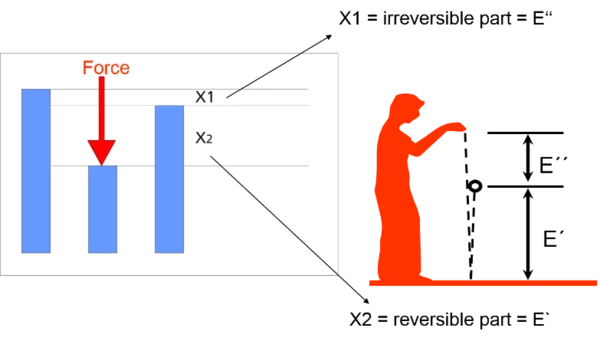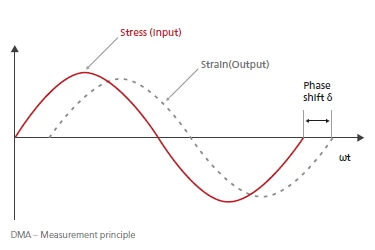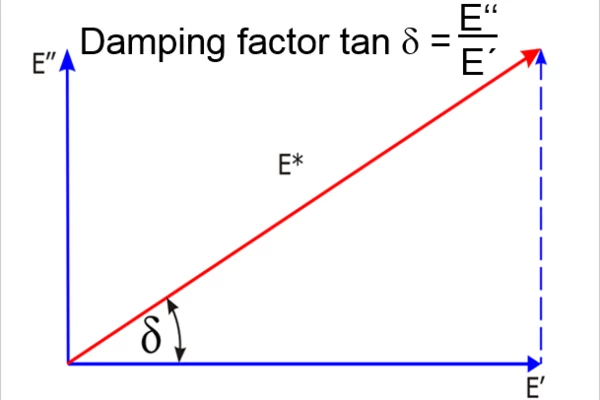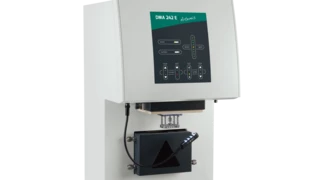methods
Dynamic Mechanical Analysis (DMA)
Dynamic Mechanical Analysis (DMA) is an indispensable tool for determining the visco-elastic properties of materials, mainly polymers.
Elastomers, for example, are very rigid below the Temperatura di transizione vetrosaLa transizione vetrosa è una delle più importanti proprietà chimico-fisiche dei materiali amorfi e semi-cristallini, come, ad esempio, vetri, metalli (amorfi), polimeri, ingredienti farmaceutici e alimentari e definisce l’intervallo di temperatura in cui le proprietà meccaniche die materiali variano da duro e fragile a più morbido, malleabile o gommoso.glass transition temperature (Tg) and have a high modulus of elasticity. Above Tg, they are flexible and show damping performance. DMA measures the visco-elastic properties during a controlled temperature and/or frequency program.

How Do Visco-Elastic Polymers Behave?
The dynamic-mechanical properties of visco-elastic polymer materials are dependent on the operating temperature, the type of oscillating force applied to the sample in a defined deformation mode and the frequency or time of the applied oscillating force. The determined modulus of elasticity of a polymer material is not a constant number, but a function of the temperature, time and frequency of the dynamic force applied to a specimen with a defined geometry.
Method
During the test, a sinusoidal force (StressStress is defined as a level of force applied on a sample with a well-defined cross section. (Stress = force/area). Samples having a circular or rectangular cross section can be compressed or stretched. Elastic materials like rubber can be stretched up to 5 to 10 times their original length.stress σ) is applied to the sample (input). This results in a sinusoidal deformation (StrainStrain describes a deformation of a material, which is loaded mechanically by an external force or stress. Rubber compounds show creep properties, if a static load is applied.strain ε; output).
Certain materials, such as polymers, exhibit viscoelastic behavior; i.e., they have both elastic properties (such as an ideal spring) and viscous ones (such as an ideal dashpot). This viscoelastic behavior causes shifting of the corresponding StressStress is defined as a level of force applied on a sample with a well-defined cross section. (Stress = force/area). Samples having a circular or rectangular cross section can be compressed or stretched. Elastic materials like rubber can be stretched up to 5 to 10 times their original length.stress and StrainStrain describes a deformation of a material, which is loaded mechanically by an external force or stress. Rubber compounds show creep properties, if a static load is applied.strain curves. The deviation is referred to as the phase shift δ. The response signal (StrainStrain describes a deformation of a material, which is loaded mechanically by an external force or stress. Rubber compounds show creep properties, if a static load is applied.strain, ε) is split into an “in-phase” and an “out-of-phase” part by means of Fourier Transformation.
The method is described in, for example, ISO 6721-1 to 12, ASTM D4065-90, ASTM D4092-90, ASTM D4473-95, ASTM D5418-99, ASTM D5023-99, ASTM D5024-95a, ASTM D5026-95a, ASTM D5279-99, ASTM E1640-94 and ASTM E1867-97.
Which Materials Can Be Tested?
From viscous liquids, rubber to fiber-reinforced plastics, from food and pharmaceuticals to metals and ceramics – all such materials can be analyzed with DMA by using different sample holders, accessories and measurement modes.



